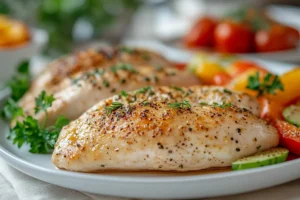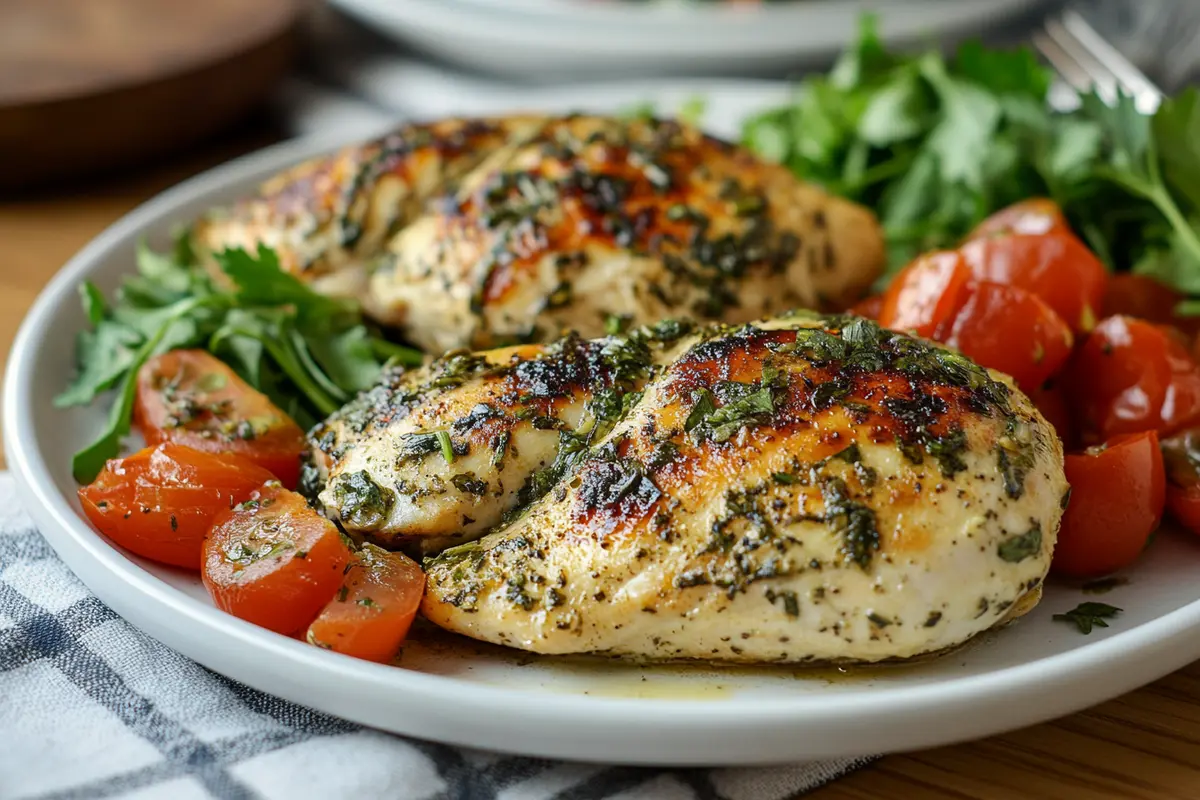Discover whether is chicken lectin-free? and learn practical tips for making the most of your meals. Explore facts, debunk myths, and uncover healthy strategies.
Welcome to this comprehensive guide where we answer the pressing question, Is chicken lectin-free? We will delve into the nature of lectins, examine how these proteins interact with chicken, and share tips for cooking and enjoying a delicious, low-lectin diet. Along the way, we will address common misconceptions, explore the benefits of different chicken-raising practices, and provide a tasty recipe for you to try.
Introduction
Lectins often appear in discussions about gut health, immune response, and dietary sensitivities. Therefore, many consumers now ask, Is chicken lectin-free? The question arises because lectins are natural plant proteins that exist in certain grains, legumes, and other foods. However, they also appear in the diets of livestock that eat high-lectin feeds. Consequently, individuals who want to minimize lectins in their meals often focus on how chickens are fed and raised. Altogether, it is essential to understand the basics of lectins and their relationship to chicken production.
Because some people are sensitive to specific lectins, particularly those found in grains, it makes sense to evaluate whether these compounds transfer to the final poultry product. After all, what chickens consume can influence the nutrients, or in some cases, anti-nutrients, in their tissues. Indeed, the concept of Is chicken lectin-free? depends on farming methods, feed composition, and cooking approaches.
What Are Lectins?
Lectins are proteins that bind to carbohydrates. They occur in various plants and sometimes in animal products if those animals consume large quantities of lectin-rich foods. Because lectins resist digestion, they may cause irritation in certain individuals, especially if consumed in large amounts or in raw forms. Nonetheless, lectins in many food sources are reduced through proper cooking, soaking, sprouting, or fermentation.
- Common foods high in lectins:
- Beans and legumes (kidney beans, soybeans)
- Whole grains (wheat, barley)
- Nightshade vegetables (tomatoes, eggplants, peppers)
- Some seeds and nuts
Many people tolerate these foods without any problem. However, others choose to limit lectin intake to manage digestive issues or reduce inflammation. Because lectins are widespread, the question Is chicken lectin-free? emerges when considering how poultry is raised and fed.
Lectins in Chicken: Fact or Fiction?
Is chicken lectin-free? Usually, chicken meat itself contains negligible lectins if the bird does not consume large amounts of high-lectin feed. However, grain-fed chickens may end up with traces of lectins in their meat and tissues. Still, these lectin amounts are often minimal compared to plant-based lectin sources, especially when the chicken is cooked thoroughly.
Key factors to consider:
- Chicken feed: Many industrial feeds use corn, soy, or wheat. These ingredients carry lectins, which could potentially pass into the bird’s system.
- Pasture-raised or free-range: Birds foraging for insects and eating minimal grains often have lower overall lectin content.
- Cooking methods: Heat can reduce certain lectins. The thorough cooking of chicken typically lowers any residual lectin effect.
Even if small lectin levels persist, they are often well below problematic thresholds. However, for those with severe lectin intolerance, seeking out pasture-raised chicken with minimal grain supplementation can offer peace of mind.
Nutritional Overview of Chicken
Besides the question Is chicken lectin-free? many people look at chicken’s nutritional profile. Chicken is a lean protein source that contains essential vitamins and minerals. Consequently, it serves as a dietary staple worldwide.
- Protein and amino acids: Chicken supplies high-quality protein, supporting muscle repair, immune function, and overall health.
- Vitamins and minerals: Chicken includes B vitamins, iron, zinc, selenium, and phosphorous. These nutrients aid energy production, red blood cell formation, and thyroid function.
- Low in saturated fat: Skinless chicken has relatively low levels of saturated fat compared to many red meats.
- Versatility: Chicken is used in diverse cuisines, making it easy to incorporate into healthy meal plans.
When we look beyond Is chicken lectin-free?, it is clear that chicken provides many nutritional advantages. Generally, it fits well into balanced diets, especially when paired with vegetables, healthy fats, and whole grains (if tolerated).

Low-Lectin Approaches and Chicken
If you follow a low-lectin or lectin-free diet, you might wonder how to best enjoy chicken without introducing unwanted lectins. The good news is that chicken, especially when carefully sourced, can be a relatively low-lectin protein choice. Here are a few strategies to keep lectins in check:
- Choose pasture-raised or free-range: Accordingly, these birds often eat grass, insects, and other natural feed, reducing their reliance on grain-based feeds.
- Look for grain-free feed: Some niche farms offer soy-free or corn-free feed, further lowering potential lectin exposure.
- Opt for well-cooked chicken: Thorough cooking can reduce or deactivate lectins that might remain.
- Combine with low-lectin sides: Serve chicken with steamed or roasted vegetables like zucchini, asparagus, or carrots instead of lectin-heavy foods.
Because lectin content can vary, consider speaking with local farmers to learn about their feeding methods. Indeed, direct communication can confirm whether the poultry aligns with your lectin-related goals.
Health Benefits of Chicken Without Lectin Concerns
While Is chicken lectin-free? remains a central question, it is important to highlight chicken’s broad range of health benefits, especially when lectin exposure is minimized.
- Gut health and digestion: Reducing lectins in your diet can alleviate bloating and discomfort for those who are sensitive. Lean chicken often integrates easily with a gut-friendly regimen.
- Weight management: Chicken’s high protein content boosts satiety. Consequently, it helps control hunger and supports lean muscle mass.
- Blood sugar stability: Adequate protein intake may help stabilize blood glucose levels, especially when paired with nutrient-dense vegetables.
- Overall nutrient density: Chicken offers a variety of vitamins and minerals that support metabolism, immunity, and cellular function.
By selecting chicken carefully, you can maximize these health perks and minimize any lectin-related worries.
Pasture-Raised vs. Conventional Chicken
To further clarify Is chicken lectin-free?, it helps to understand the differences between pasture-raised and conventional chicken. These farming systems significantly impact feed composition and overall bird health.
- Conventional chicken: Often raised in large barns, these birds typically receive a diet that includes corn or soy. Because these feeds are high in lectins, conventional birds may contain marginally higher lectin residues. However, cooking helps reduce possible lectin activity.
- Pasture-raised chicken: Raised outdoors with access to grass, insects, and natural forage. This approach can lower reliance on grain-based feeds. Consequently, it may reduce any potential lectin transfer. Furthermore, pasture-raised chickens often have more nutritious meat with higher omega-3 fatty acids and vitamins.
Many consumers choose pasture-raised options for ethical, environmental, and dietary reasons. They view these chickens as a safer bet for minimizing lectins and maximizing flavor.
Common Misconceptions About Chicken and Lectins
- Myth: “All animal proteins contain lectins.”
Animal protein by itself generally does not contain significant lectins unless the animal consumes large amounts of lectin-rich feed. Hence, properly raised chickens typically have negligible lectin content. - Myth: “Eating chicken always leads to inflammation.”
While certain lectins can cause inflammation in sensitive individuals, the trace amounts in chicken (if any) are often minimal. Selecting grain-free or pasture-raised poultry, or simply cooking your chicken well, can further reduce any possible lectin issues. - Myth: “Organic chicken is always lectin-free.”
Organic merely means the birds and their feed follow specific USDA guidelines, including no synthetic pesticides or fertilizers. They can still be fed organic corn or soy, which may contain lectins. Therefore, organic does not necessarily mean lectin-free. - Myth: “Lectin-free diets exclude chicken entirely.”
Most lectin-aware plans do not exclude chicken. Instead, they prioritize well-sourced, properly cooked chicken to ensure minimal lectin exposure.

Shopping Tips for Is Chicken Lectin-Free?
When trying to answer Is chicken lectin-free? on your shopping trip, focus on these points:
- Look for pasture-raised labeling: Seek out farms or producers that emphasize limited grain use or alternative feed methods.
- Read packaging carefully: Terms like “free-range” can be misleading. Do your research or ask questions to verify how much outdoor space chickens actually get.
- Inquire with local farmers: Find out if they use soy, corn, or wheat in their feed. Ask if there is an option for grain-free poultry.
- Purchase in bulk: If you find a trustworthy farmer or store, consider buying multiple chickens. Freeze them for future use, ensuring a consistent supply of low-lectin protein.
Staying informed helps you choose poultry that fits your dietary needs. Is chicken lectin-free? becomes easier to manage when you know the source.
Recipe Inspiration: Easy Is Chicken Lectin-Free? Meal
Below is a quick overview of a tasty dish that focuses on low-lectin principles. You will find the expanded instructions in the post-article section. For now, here is a snapshot of how you can prepare a simple, flavorful chicken meal:
- Focus on fresh ingredients: Use chicken from a pasture-raised, minimal grain feed source.
- Marinade with low-lectin herbs: Consider rosemary, thyme, oregano, and garlic (if tolerated).
- Cooking method: Bake or grill at moderate heat to ensure thorough cooking without drying out.
- Sides: Pair with steamed zucchini, sautéed mushrooms, or cauliflower rice to keep your plate low in lectins.
This straightforward approach illustrates how to enjoy chicken without worrying excessively about lectins. Meanwhile, you still benefit from the meat’s lean protein and essential nutrients.

“Benefits Recipes”
The idea of Is chicken lectin-free? resonates with those following gut-friendly and inflammation-reducing meal plans. Thus, the recipe we share provides several key advantages:
- Reduced digestive strain: Minimizing lectins often eases bloating and discomfort for sensitive individuals.
- Steady energy: Lean chicken protein supports balanced blood sugar levels.
- Rich nutrient profile: Chicken supplies vital vitamins and minerals essential for daily function.
- Versatile meal planning: You can pair your chicken dish with a wide range of low-lectin vegetables.
- Approachable cooking techniques: Our recipe uses basic steps that most home cooks can master quickly.
Consequently, these benefits recipes make it simpler to maintain a healthy, lectin-conscious lifestyle that remains enjoyable and varied.
Conclusion
So, Is chicken lectin-free? Largely, yes, especially when chickens are not heavily reliant on grain-based feeds. Even conventionally raised chicken typically contains minimal lectins, further reduced by thorough cooking. Nonetheless, individuals aiming to avoid lectins entirely should search for pasture-raised, grain-free fed poultry or talk to local farmers about their feeding practices. Ultimately, chicken can be a nutritious, high-protein food choice, especially if you are aware of possible lectin sources and how to mitigate them.
By choosing well-sourced chicken, cooking it properly, and pairing it with low-lectin side dishes, you can fully enjoy your poultry meals. Remember that the total lectin content in chicken is modest compared to beans, wheat, and other plant-based lectin sources. Thus, you can incorporate chicken confidently into a balanced diet that prioritizes gut health, energy, and satisfaction.
Frequently Asked Questions (FAQs)
Can pasture-raised chicken be organic?
Yes. Pasture-raised chicken can also carry organic certification if it meets organic feed standards and avoids synthetic pesticides. However, “organic” does not always imply soy-free or corn-free. Always verify the feed components if lectin content matters to you.
What meats are lectin-free?
Most unprocessed meats, including beef, lamb, turkey, fish, and chicken, have negligible lectins on their own. The main concern arises from what the animals eat. Selecting animals not fed with high-lectin grains is ideal for those aiming to avoid lectins entirely.
Do pasture-raised chickens eat grain?
Yes, sometimes. Many pasture-raised chickens still receive supplemental grain feed, though usually less than conventionally raised birds. Look for farms that limit or omit soy, corn, and wheat if you are highly sensitive to lectins.
Recipe: Is Chicken Lectin-Free? A Simple Low-Lectin Chicken Dish
Below is a detailed recipe that highlights how to prepare chicken in a way that further reduces potential lectin exposure. It uses straightforward ingredients and steps, making it perfect for busy weekdays or casual weekend meals.
Ingredients
- 1 whole pasture-raised chicken (approximately 3–4 lbs)
- 2 tablespoons extra-virgin olive oil
- 1 teaspoon sea salt (adjust to taste)
- 1 teaspoon freshly ground black pepper
- 1 tablespoon dried thyme
- 1 tablespoon dried oregano
- 1 tablespoon dried rosemary (optional)
- 2 cloves garlic, minced (optional if you tolerate small amounts of lectins)
- 1 cup water or low-lectin chicken stock
Step-by-Step Expanded Cooking Instructions
- Preparation
- Preheat your oven to 375°F (190°C).
- Rinse the chicken under cold water and pat it dry with paper towels.
- Place the chicken in a roasting pan or baking dish.
- Seasoning
- In a small bowl, combine olive oil, sea salt, pepper, thyme, oregano, and rosemary if desired.
- Mix these seasonings until well blended.
- Rub the mixture generously all over the chicken. Make sure to coat the inside cavity as well.
- Adding Garlic (Optional)
- If you tolerate minimal lectins in garlic, add minced garlic to the seasoning mix or place it under the chicken skin.
- For a milder flavor, toss the garlic into the baking dish around the bird.
- Roasting
- Pour one cup of water or low-lectin chicken stock into the roasting pan to keep the chicken moist.
- Put the chicken in the oven and roast for about 20 minutes per pound (60–80 minutes total for a 3–4 lb bird).
- Check periodically. Add more water or stock if the liquid evaporates.
- Checking Doneness
- Insert a meat thermometer into the thickest part of the thigh, avoiding bone.
- The chicken is done when it reaches an internal temperature of 165°F (74°C).
- If the skin browns too quickly, tent the chicken with aluminum foil.
- Resting and Serving
- Remove the chicken from the oven and let it rest for 10 minutes. This step allows the juices to redistribute.
- Carve the chicken into pieces. Serve with your favorite low-lectin side dishes, such as zucchini noodles or cauliflower rice.
Nutritional Information (per 100g)
| Nutrient | Amount |
|---|---|
| Calories | 165 kcal |
| Protein | 31 g |
| Fat | 3.6 g |
| Saturated Fat | 1 g |
| Carbohydrates | 0 g |
| Fiber | 0 g |
| Sodium | 100 mg |
| Iron | 1 mg |
